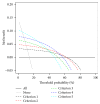Predicting Low-Risk Prostate Cancer from Transperineal Saturation Biopsies
- PMID: 27148459
- PMCID: PMC4842366
- DOI: 10.1155/2016/7105678
Predicting Low-Risk Prostate Cancer from Transperineal Saturation Biopsies
Abstract
Introduction. To assess the performance of five previously described clinicopathological definitions of low-risk prostate cancer (PC). Materials and Methods. Men who underwent radical prostatectomy (RP) for clinical stage ≤T2, PSA <10 ng/mL, Gleason score <8 PC, diagnosed by transperineal template-guided saturation biopsy were included. The performance of five previously described criteria (i.e., criteria 1-5, criterion 1 stringent (Gleason score 6 + ≤5 mm total max core length PC + ≤3 mm max per core length PC) up to criterion 5 less stringent (Gleason score 6-7 with ≤5% Gleason grade 4) was analysed to assess ability of each to predict insignificant disease in RP specimens (defined as Gleason score ≤6 and total tumour volume <2.5 mL, or Gleason score 7 with ≤5% grade 4 and total tumour volume <0.7 mL). Results. 994 men who underwent RP were included. Criterion 4 (Gleason score 6) performed best with area under the curve of receiver operating characteristics 0.792. At decision curve analysis, criterion 4 was deemed clinically the best performing transperineal saturation biopsy-based definition for low-risk PC. Conclusions. Gleason score 6 disease demonstrated a superior trade-off between sensitivity and specificity for clarifying low-risk PC that can guide treatment and be used as reference test in diagnostic studies.
Figures

References
-
- Thompson J. E., Moses D., Shnier R., et al. Multiparametric magnetic resonance imaging guided diagnostic biopsy detects significant prostate cancer and could reduce unnecessary biopsies and over detection: a prospective study. The Journal of Urology. 2014;192(1):67–74. doi: 10.1016/j.juro.2014.01.014. - DOI - PubMed
LinkOut - more resources
Full Text Sources
Other Literature Sources
Research Materials
Miscellaneous

